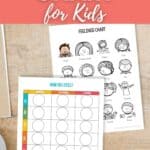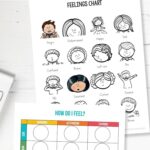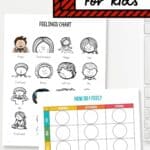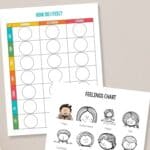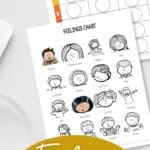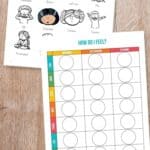Feelings Chart for Kids
Kids can have some big feelings. And sometimes, they don’t know how to express those feelings in a healthy way, or in a way that they can be heard. Using a chart like this feelings chart for kids can be a good way to help them recognize, name, understand and express their feelings in a good way, rather than being destructive.
If you love this printable, check out these amazing health worksheets for kids!
There’s nothing wrong with having feelings. It’s just how you express those feelings that can be destructive and unhealthy. We need to teach our kids how to recognize and name their emotions, and to understand what and why they feel the way they feel.
And then we can show them how to express their feelings in a healthy way. Helping kids manage their emotional health is part of helping them grow up healthy.
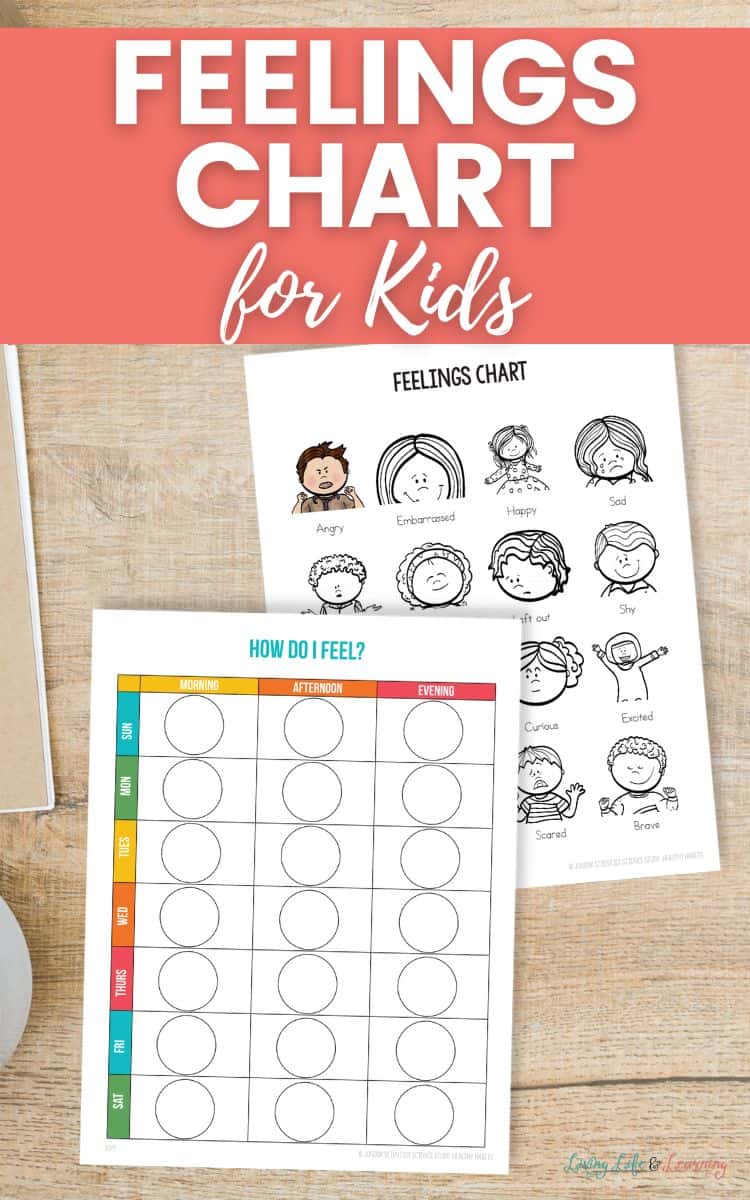
Teaching kids about healthy food and habits? I have fun activities, printables, and more, on this list of Health and Hygiene for Kids.
The first step to managing emotional health is to help kids recognize what they’re feeling. Give your kids the names of their feelings, and that will help them use words rather than their hands or bodies to express how they feel.
Start young, with simpler categories such as happy, sad, and mad, and as your kids get older, give them more complex names, such as disappointed, frustrated, or delighted.
We tend to focus on the negative feelings but don’t forget to name the positive feelings too. Give your kids the names for the satisfaction of a job well done, the pride in achievement, or the delight of a surprise gift.
If you like this activity, check out my list of Healthy Body Activities for Preschoolers to get more ideas on what activities are perfect when teaching kids about living a healthy lifestyle.
This post may contain affiliate links meaning I get commissions for purchases made through links in this post. Read my disclosure policy here.
Recommended Books About Emotions
One of the best ways to teach kids about their emotions is to start with a story. Stories can connect with kids in a visual way that helps them see emotions and learn to name them. Here are a few of our favorite stories about emotions for young children. What would you add to this list?
The Color Monster: A Story About EmotionsWhen I am Angry: Kids Books about Anger, ages 3 5, children’s books (Self-Regulation Skills)The Feelings BookThe Angry Dragon: (anger management, ages 3 5, picture, preschool, kids books) (Emotions & Feelings)How I Feel: Emotions & Feelings Books For Kids, Children Ages 4 6, Preschool, Activity PagesMy Whirling Twirling Motor

Recommended Emotion Activity Kits for Kids
When it comes to helping kids learn, there is nothing more important than doing hands-on activities. Activity kits provide a fun and educational way to engage kids in creative and active play without them even knowing they’re learning!
There are so many wonderful options for kids of all ages and skill levels. If you want your kids to be more aware of their emotions, here are some toys I recommend for you!
Social Emotional Learning Toy, Funny Faces Games with 28 Facial Expressions and 12 Emotional FlashcardsSee My Feelings Mirror, Social Emotional Learning ActivitiesA Little SPOT of Emotion 8 Plush Toys with Feelings Book Box SetFeelings Flashcards Game Emotion Cards for Learning Emotions20 PCS Emotion Squeeze Balls Funny Face Stress Relief BallsSocial Emotional Learning Activities Emotion Cards for Kids
How to teach your kids about feelings
A great way to teach about feelings is to help your kids recognize the emotions of others. You could play a silly-face game, where you take turns making faces to express various emotions and try to guess what the other is pretending to feel. Point out what emotion people’s faces show when reading stories or watching a show with your kids.
Take every opportunity to give your kids the words for their feelings. When they get upset, you could say, “You seem very frustrated by this. Can I help?” or “I see that you’re angry.
Do you need some time to calm down?” And when they are jumping or laughing, say “I love how excited you are about this,” or “You look like you’re really enjoying that story.”
A simple way to start is to use this feelings chart. Every morning, ask your child how they’re feeling, and mark it on the chart. Then you can talk about why they’re feeling that way, or what might make them feel differently.
The benefits of teaching kids about feelings
Once kids can recognize and name their feelings, it’s a lot easier to help them deal with those feelings and share how their feeling in a productive way. Kids who can name their feelings and have the words to express them are more likely to use their words and less likely to tantrum or act out.
Teaching our kids about their feelings is part of our job as parents. So grab this simple tool to help make your job easier.
More Feelings Activities
Want more ways to encourage your children? Try this Free printable positive affirmations for kids.
Try these free calm down printables to help your children control their emotions.
Download the feelings chart for kids below
Print out the feelings chart to help your kids keep track of their emotions throughout the day.
Go ahead and print out this feelings chart to help your child keep track of the moods and to help them learn that it’s okay to have all of these feelings throughout the day as it changes constantly.
More Health Activities
Health Activities for Preschoolers
Even young kids should learn about health and hygiene, too! Check out these fun and engaging health activities that are perfect for preschoolers!
Printable Yoga Cards for Preschoolers
Free Printable Emotion Faces and Activities by Natural Beach Living

